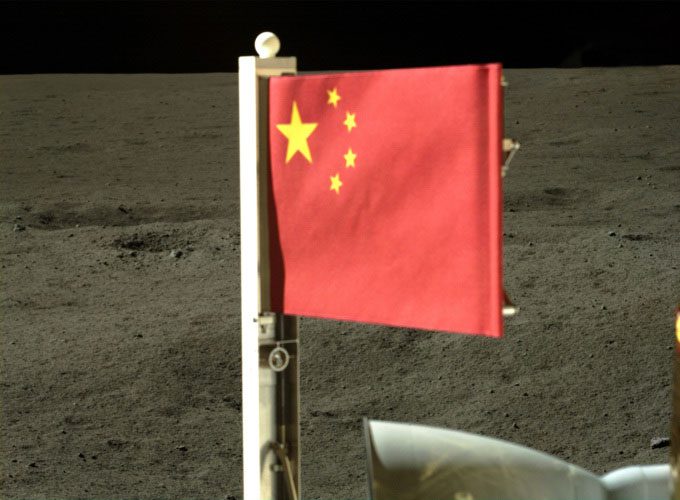The Chinese national flag on the Moon is made from inorganic basalt fibers, which are highly thermal-insulating and radiation-resistant, and is only one-third the thickness of a human hair.
Chinese scientists have revealed details about the creation of this special flag that was raised by the lander of the Chang’e 6 mission on the Moon last week, ECNS reported on June 9. The flag was designed to withstand extreme conditions such as average temperature fluctuations, high and low temperatures, a vacuum environment, and strong ultraviolet radiation. This is also the first national flag in the world to be raised on the far side of the Moon.

The Chinese flag was raised by the Chang’e 6 lander on the far side of the Moon on June 4. (Photo: China Daily).
The special flag is made from basalt fibers developed in collaboration between Wuhan Textile University and the Sanjiang Group of China Aerospace. Xu Weilin, a scholar at the Chinese Academy of Engineering (CAE) and president of Wuhan Textile University, along with colleagues, successfully created a high-quality “stone version” of the fabric national flag after overcoming significant challenges over the past four years, including difficulties in weaving the fibers and ensuring the colors do not fade.
Basalt fibers are inorganic, highly thermal-insulating, and radiation-resistant, making them suitable for the harsh environment on the Moon, Xu stated. However, characteristics of basalt fibers, such as their smooth surface, brittleness, and fragility, posed challenges during the spinning and weaving processes.
The flag of the Chang’e 6 mission is the same size as the flag planted during the Chang’e 5 mission on the near side of the Moon, measuring approximately 30 cm x 20 cm, equivalent to A4 paper size. The density of the basalt fibers used for the Chang’e 6 flag is nearly double that of the material used for the Chang’e 5 flag. Therefore, the basalt flag would generally be heavier. However, Xu’s team developed ultra-fine basalt fibers with a diameter of about one-third that of a human hair, resulting in a final weight of only 11.3 grams, which is 0.5 grams lighter than the Chang’e 5 flag.
Xu stated that basalt fibers are lightweight and flexible, making them increasingly useful in the aerospace sector, for example, in the production of spacesuits, spacecraft, and lunar bases. His team has begun researching applications of basalt fibers in areas requiring heat resistance and fire protection, such as protective clothing and bags, maximizing the capabilities of ultra-fine basalt to withstand special environmental conditions.
Fireproof suits made from basalt fibers not only provide fire resistance and thermal insulation but are also cost-effective, according to Cao Genyang, a professor in Xu’s team who also participated in developing the Chang’e 5 flag. “Basalt fibers cost 25,000 yuan (3,450 USD) per ton, which is significantly lower than quartz and carbon fibers, thus the market prospects are very promising,” he stated.
Typical firefighting suits and life-saving ropes are usually made from organic materials that can ignite when exposed to temperatures around 550 degrees Celsius. “The melting temperature of basalt fiber suits is 1,600 degrees Celsius, so they can be used for short periods at 1,200 degrees Celsius and for long periods at 800 degrees Celsius,” Cao explained. He also mentioned that fire suits, fire-retardant blankets, and related products made from basalt fibers will gradually be produced in the coming years.


















































